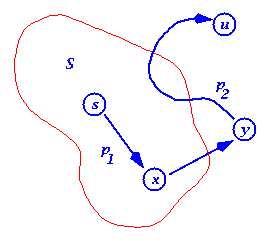|
Data Structures and Algorithms
|
| Proof of Dijkstra's Algorithm
|
We use a proof by contradiction again.
But first, we assert the following Lemma:
| Lemma 1
Shortest paths are composed of shortest paths.
The proof of this is based on the notion that if
there was a shorter path than any sub-path, then
the shorter path should replace that sub-path to
make the whole path shorter.
|
| Lemma 2
If s ->..-> u -> v is a shortest path from s to v,
then after u has been added to S and relax(u,v,w)
called, then d[v] = delta(s,v) and d[v] is not
changed thereafter.
For formal proofs, see Cormen or any one
of the texts which cover this important algorithm.
Proof follows from the fact that at all times
d[v] >= delta(s,v).
|
Denote the distance of the shortest path from s to u
as delta(s,u).
After running Dijkstra's algorithm, we assert that
d[u] = delta(s,u) for all u.
Note that once u is added to S,
d[u] is not changed and should be delta(s,u).
Proof by contradiction
Suppose that u is the first vertex added to S
for which d[u] != delta(s,u).
We note:
- u cannot be s, because d[s] = 0.
- There must be a path from s to u.
If there were not, d[u] would be infinity.
- Since there is a path, there must be a shortest path.
 |
Let s -(p1)-> x -> y -(p2)-> u be the shortest path
from s to u.
Where x is within S and y is the first vertex not within S.
|
When x was inserted into S, d[x] = delta(s,x)
(since we hypothesise that u was the first vertex
for which this was not true).
Edge (x,y) was relaxed at that time, so that
d[y] = delta(s,y)
<= delta(s,u)
<= d[u]
Now both y and u were in V-S when u was chosen,
so d[u] <= d[y].
Thus the two inequalities must be equalities,
d[y] = delta(s,y) = delta(s,u) = d[u]
So d[u] = delta(s,u) contradicting our hypothesis.
Thus when each u was inserted,
d[u] = delta(s,u).
QED
© John Morris, 1998
